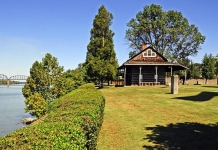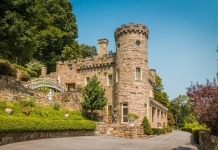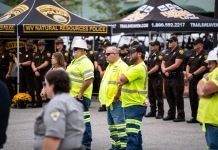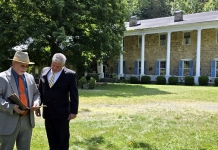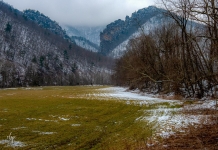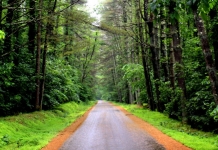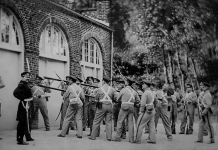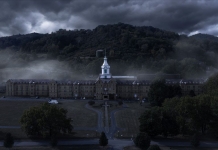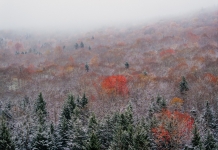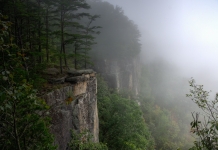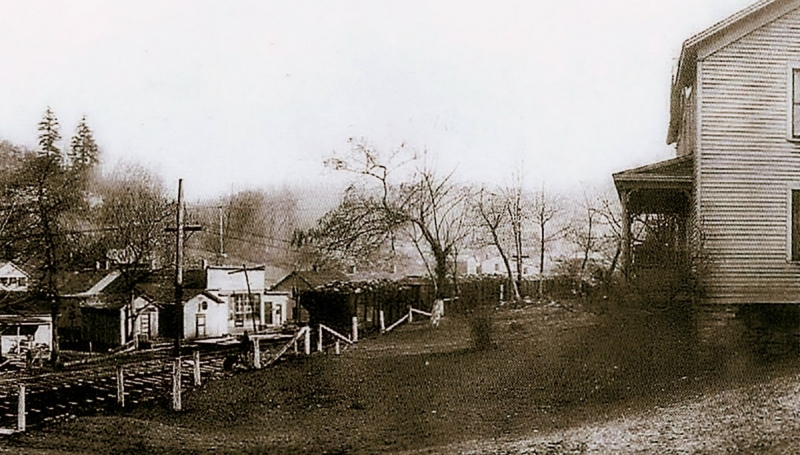
Winona, West Virginia (WV), may be classified as one of the remaining inhabited ghost towns of the New River Gorge region. Though with fewer than 200 residents today, it claimed as many as 1,100 in 1910 when its coal mines were booming. It may be best known for its association with outdoor recreation because of its location near the Beauty Mountain rock climbing area and the Nuttallburg Coal Mining Complex and Town Historic District.
Thousands of hikers, paddlers, and rock climbers visit the area annually, and many have moved to the area coincident with the establishment of the New River Gorge National Park and Preserve.
Prehistory
The area in and around Winona had been inhabited by Native Americans for more than 80,000 years. In more recent prehistoric times it was inhabited by people who buried their deceased among the prominent cliffs found throughout south-central West Virginia. In the 1650s the Iroquois of northern New York laid claim to the area and removed native inhabitants who may have been of the eastern Sioux peoples, according to artifacts left behind. In the early 1700s, Native Americans from other areas, notably the Shawnee of Ohio, began to return to the region to hunt and harry new Virginian settlements.
Early History
The site of Winona was owned by Robert M. Holliday, Sr., a pioneer farmer who settled the area before the Civil War. In the 1870s, he sold his mineral rights to John Nuttall, who then began to develop the surrounding coalfields. The town is located near "Spy Rock," a lofty rock formation used by spies for both Union and Confederate armies to watch movement along trails through the area. The town and its post office were named for Winona Gwinn, the eldest daughter of William Gwinn, who operated a hotel there.
Dr. Carter G. Woodson
Dr. Carter G. Woodson (1875-1950), the "Father of Black History," began teaching public school at Winona, where he worked from 1898 to 1900. Before Woodson, little of black culture in the U.S. was documented and collected. Woodson’s home in Washington, D.C., is a national historic site and headquarters for the Association for the Study of African American Life and History.
Coal Mining History
The development of the coal lands surrounding Winona occurred due to the efforts of John Nuttall, who had by the 1880s acquired a tract of 30,000 acres of coal lands along Keeney's Creek in the highlands above his coal operations in the New River Gorge at Nuttallburg, which he had opened in 1873.
Nuttall attempted to interest the Chesapeake & Ohio Railway in building a branch line railroad into his coal lands, but the railroad was not interested in investing in the building of the branch. In 1891, under an agreement with the Chesapeake & Ohio Railway (C&O), Nuttall financed the building of a branch line railroad from a point on the C&O mainline near Nuttallburg into the areas of present-day Winona and Lookout. The branch line was completed five miles to Rothwell (Dubree) in 1893 and extended to Lookout in 1894. Following the completion of the branch, the C&O assumed operation, naming it the Keeney's Creek Branch.
Because Nuttall could not afford to fund both the building of the railroad and the development of the mines, he offered leases on his coal lands along Keeney Creek to friends and employees. William Holland and Fred Rothwell were among the early leaseholders. As part of his terms, Nuttall was paid a royalty on each ton of coal mined and received a "shipping fee" of $0.05 per ton hauled on the Keeney's Creek Branch.
Coal companies operating mines in the vicinity of Winona began shipping on the branch. All mines were drift mines working the Sewell seam. George Holland opened a mine for the Ballenger Coal Co. in 1893. The "Smokeless" mine was first opened by William Masters in 1893 under the name of Masters Coal Co., later operated by John Campbell and Sam Turner, but then by Lee Long, and, next, by Bell & Wood. The Boone mine was opened by W. F. Boone, later operated by Lee Long, followed by Bell & Wood. The Dubree mine was opened by Rothwell Coal Co. in 1893 and was later operated by Harrison B. and Alex Wood. Coal companies operating on the Keeney's Creek Branch circa 1896 included Boone Coal & Coke Co., Ballinger Coal & Coke Co., Smokeless Coal Co., Rothwell Coal Co., and Blume Coal & Coke Co. at Lookout. The Quarrier mine was opened in 1897 by the Rothwell Coal Co. but ceased operation in 1902. The Rosewell mine was opened by the same company in 1907.
The company store of the Rothwell mining operation was known as the Dubree Company Store. A post named Dubree was established at some unknown date but closed in about 1920. The Dubree store, established in 1893, was destroyed by fire in 1922 and apparently never rebuilt. The Ballenger and Smokeless coal operations both opened company stores in 1894. Many other businesses operated in Winona during its heyday, apparently because the coal companies didn't own the surface rights to much (or perhaps none) of the town itself.
Businesses operating in the town during its boom included a drug store, several general merchandise stores, dry goods stores, a meat market, a pool room, a millinery business, a barber shop, several hotels, a lodging house, and a movie theatre. The Winona National Bank was organized on September 17, 1910. Several fraternal organizations were represented at Winona, including a Masonic lodge chartered in 1903. The population of Winona was estimated at 1,100 in 1910 by the West Virginia Geological Survey.
Several churches were located in Winona or its nearby mining communities, including a Methodist Episcopal church, organized in 1894; a Presbyterian church, erected in the early-1890s at Dubree; a Catholic church, built in 1906; and a Baptist church, organized in 1910. The first school at Winona was a one-room building, the first classes being taught there in 1895 by a Mr. Clay. Enrollment that first year was 75 students. Three rooms were added to the building in 1897. A new graded school building was erected in 1910, and the old school building was used as a retail store building afterward, occupied by the Hall & Stemple store. The enrollment of the school was 200 pupils by the mid-1920s.
In 1917, the Maryland New River Coal Company, of Philadelphia, PA, acquired the Smokeless and Boone mines, and in 1919 the company acquired the Dubree and Rosedale mines. The Maryland-New River Coal Company was chartered in West Virginia on April 6, 1917. Incorporators of the company were J. M. and W. D. Payne of Charleston, WV, and others. J. M. Payne had been an investor in the Central mine at Beury, and was a stockholder in various mining, oil, gas, and transportation companies as well as other industrial and manufacturing-related operations in West Virginia.
During the Maryland-New River ownership period, improvements were made to the company-owned homes and stores and modernization of the company's mining operations occurred. New metal screening and processing plants were built at the mines replacing the old wooden tipples, and modern machinery was installed in the mines for the mining of coal. The Maryland New River Club House was opened in Winona in 1919. During the late 1920s, the Maryland New River Coal Company further expanded its coal holdings in the New River Coalfield with the acquisition of the lease to the Nuttallburg coal operations. By 1953, all of the mines of the Maryland New River Coal Co. had ceased operation.
In the year ending June 30, 1923, the Maryland-New River Company operated the mines known as Boone, Durbree, Rosedale, and Smokeless—all drift mines working the Sewell seam, with thickness averaging 3 ft.-6 in. The company employed 244 workers who worked 80 days. Both pick mining and machine mining were employed, and one steam and eight electric locomotives and twenty-eight mules were used to move the coal. J. W. Garvey was superintendent with J. E. Davis, S. S. Sandigo, Charles Higgins, and W. H. Gross as foremen.
The Garvey House
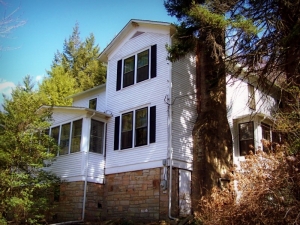
The former home of mine superintendent J.W. Garvey, the Garvey House is among the best-preserved residential properties in the northern New River Gorge region, known for its rock gardens, built at Mrs. Garvey's direction.
In the 1970s, the house became one of the region's first bed-and-breakfast inns, catering to whitewater rafters. The region is now among the most popular rock climbing destinations in the U.S.






